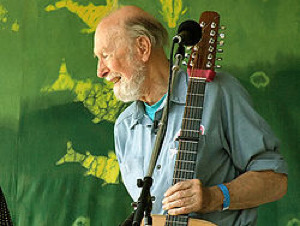71 years ago today, two men were rescued from a semitrailer that crashed over the side of the Pit River Bridge before it fell into the Sacramento River. At the same time, amateur photographer Virginia Schau photographed the effort and won the Pulitzer Prize for Photography as a result. She became the first woman to win the award. She captured the photo with a Kodak brownie. READ more… (1953)

On May 3, 1953, at the opening of the fishing season along the upper Sacramento River, Walter and Virginia Schau decided to take her parents, Mr. and Mrs. Brown, out for a day of fishing. Virginia Schau brought along a Brownie camera that her sister had given to her some years back, although she said later: “I’m the kind of person who always takes a camera on a trip and never takes a picture.”
In the picture, the cab is dangling over the bridge with drivers Overby and Baum trapped inside. The rear wheels of the cab were jammed between the side of the bridge and the trailer, which had miraculously remained on the bridge. Virginia’s husband, Walter Schau, and the driver behind him, J. D. McLaren of Concord, California, stopped traffic, found a length of rope, and with the help of other motorists, attempted to rescue Overby and Baum from the dangling cab.
Virginia Schau, from her vantage point, was able to get off two pictures, using the last two exposures in her camera. Schau’s father reminded her of the Sacramento Bee’s weekly photo contest. She submitted the photograph, won the contest—and ten dollars—and the photograph was picked up by the Associated Press and distributed globally. Almost a year to the day later, Virginia Schau was “flabbergasted” to hear that her picture of the rescue had won the 1954 Pulitzer Prize for Photography, which came with a $1,000 prize.
The money came in handy for defraying the hospital bill concerning the birth of her first-born child, a son.
MORE Good News on this Day:
- Washington, D.C. was incorporated as a city (1802)
- The Anne Frank House opened in Amsterdam to showcase the life, the diary, and death of the 14-year-old holocaust hero (1960)
- Margaret Thatcher became Britain’s first female prime minister (1979)
- Soviet leader Andropov decreased nuclear weapons in Europe (1983)
- The first Bob Dylan radio program, “Theme Time Radio Hour”, aired on XM Satellite Radio—lasting for 3 years, it featured an eclectic mix of blues, rock, folk, rockabilly, R&B, soul, country, and pop music, centered on a single theme, like “weather,” “money,” or “flowers” (2006)
- The UN Convention on the Rights of Persons with Disabilities went into force, one month after the required twentieth country ratified the landmark treaty which guarantees the rights of some 650 million people worldwide (2008)
91 years ago today, the Godfather of Soul was born in South Carolina. James Brown, aka “Soul Brother No. 1” aka “Mr. Dynamite,” had a career that lasted more than 50 years, during which he influenced the development of several music genres. Brown was one of the first 10 inductees into the Rock and Roll Hall of Fame at its inaugural induction in New York on January 23, 1986. Rolling Stone magazine called him the 7th greatest musical artist of all time.

James Brown released 60 records from 1958 – 2002, during which he was instrumental in developing 50s gospel and early soul into funk and R&B, and eventually hip hop. In 1971 his group the JBs, which included the Collins brothers, Bootsy and Catfish, released Get Up (I Feel Like Being) a Sex Machine, which cemented the early funk sound. Once the Collins’ left the JBs they formed the legendary Parliament-Funkadelic.
His performances were intense, and it was always his goal to “make people tired.” A former saxophonist told NPRs Fresh Air that every band member had to be on time for every rehearsal with special colored-leather shoes (shined) and a bowtie. Fines were imposed by Brown on any musician who did not pass inspection.
He also employed his music for social activism, chiefly to help encourage students to stay in school, and recorded songs in the 1960s like Don’t Be a Drop Out, the sales from which went to school advocacy among black youth.
“I have a lot of musical heroes but I think James Brown is at the top of the list”, remarked Public Enemy’s Chuck D. “Absolutely the funkiest man on Earth… In a black household, James Brown is part of the fabric…” WATCH exactly what he meant by making an audience tired… (1933)
53 years ago today, National Public Radio broadcast its very first original news program—All Things Considered. NPR had debuted earlier that year with around 88 Member stations of non-commercial, educational, or community radio stations, 55 employees, and almost 2 million listeners.

On that first broadcast, NPR journalists, including Jeff Kamen, covered a rally of 20,000 people in Washington, D.C. who were protesting the Vietnam War. ATC aired a 24-minute sound portrait of the event and Susan Stamberg was working as a production assistant when the show debuted.
She says the initial broadcast felt like a revelation. “We were creating it from scratch. There was no template for it.” A year later, Stamberg made history as the first woman to anchor a daily national news program in America—and for 14 years she co-hosted ATC, which blended hard news with arts and general interest stories.
ATC creator and NPR’s first director of programming, Bill Siemering says he remembers being aspirational, offering a few core values for the network to follow—it become engrained in NPR’s mission statement:
National Public Radio will serve the individual. It will promote personal growth. It will regard individual differences with respect and joy rather than derision and hate. It will celebrate the human experience as infinitely varied rather than vacuous and banal. LISTEN to an interview with the founding pair… (1971)
And, 87 years ago today, Gone with the Wind, a novel by Margaret Mitchell, won the Pulitzer Prize for Fiction.

The only novel published by the journalist, it’s a story set in the American Civil War depicting the struggles of young Scarlett O’Hara, the spoiled daughter of a rich plantation owner, who must use any means to claw her way out of poverty after the destruction of Atlanta. As of 2014, a poll of Americans found it to be the second favorite book, just behind the Bible. More than 30 million copies have been printed worldwide—and it also won the 1936 National Book Award the year. (1937)

Also, 76 years ago today, the first broadcast of the “CBS Evening News” aired—the longest-running network news show in U.S. history. It originally ran as a 15-minute broadcast each weeknight anchored by Douglas Edwards, and it was the first scheduled network TV news program to use an on-camera anchor. 14 years later, reporter Walter Cronkite took the helm of the news desk where he stayed for nearly two decades. WATCH Cronkite’s reaction to man landing on the moon… (1948)
And, on this day 24 years ago, the sport of geocaching began. The worldwide hide-and-seek game involves containers hidden, but logged with GPS coordinates on the internet.
A typical cache is a small waterproof container with a logbook (and pencil). The geocacher enters the date they found it and signs it with their established code name. After signing the log, the cache must be placed back where the person found it. Larger containers also include items for trading, usually toys or interesting items of little financial value. Dave Ulmer (above) hid the first geocache, and the plaque in Beavercreek, Oregon commemorated the start. (2000)

Also, 132 years ago today, the folk singer, musician, and activist Pete Seeger was born. He had a string of hit records during the early 1950s as a member of the Weavers and was a prolific songwriter who co-wrote classics like Where Have All the Flowers Gone?, Turn! Turn! Turn!, and If I Had a Hammer. In the 1960s, his voice was a fixture at protest rallies concerning disarmament and the environment—and he popularized the spiritual We Shall Overcome as an anthem for the Civil Rights Movement. In fact, he changed the lyric from the traditional “We will overcome” to the more singable “We shall overcome”.

A posthumous six-CD collection with a 200-page book was released for the 100th anniversary of his birth, entitled Pete Seeger: The Smithsonian Folkways Collection. It features 20 unreleased tracks that spotlight Seeger’s pacifism, activism, and “straightforward, inquisitive songwriting style.” Check out centennial events around North America, new unreleased tracks on CD, and WATCH a tribute from after his death in 2014 at the age of 94… (1919)
SHARE the Milestones, Memories, and Music…




















Its nice to hear the positive example of May 3 in Russian history, especially because of the recently renewed conflict between Estonia and Russia. Peace-keeping is what we really would like to stabilize. Let’s send a positive thought in that direction. Intend for it.
[…] post What Good Happened on May 3? appeared first on The Good News […]
[…] post Good News in History, May 3 appeared first on Good News […]
[…] post Good News in History, May 3 appeared first on Good News […]
[…] Source: Good News Network […]
[…] Posted From: https://www.goodnewsnetwork.org/events060503/ […]